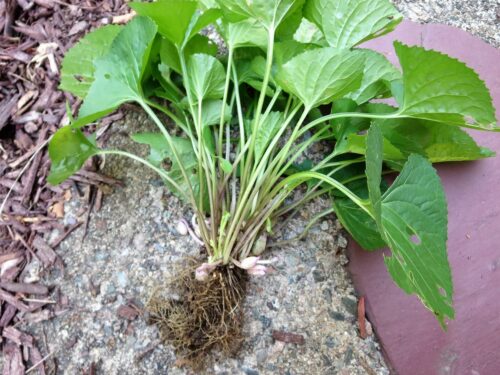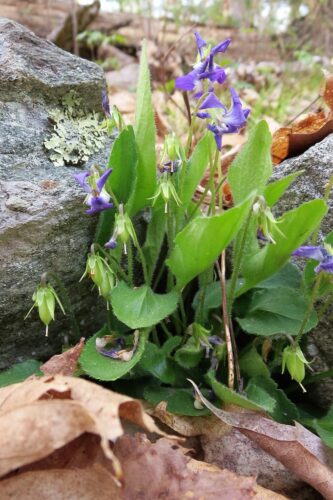One late-August day, many years ago, I decided to do a little weeding, and I pulled up a big violet plant that was growing somewhere that it didn’t belong.

Near the base of the plant were what appeared to be seed pods. I opened a pod up, and sure enough, there were seeds inside.

That was odd. Why would a plant that flowers in early spring still have seed pods in late August? And why would the seed pods be so low on the plant when the flowers typically grow so much higher? That’s when I realized that the violet had a secret, though I didn’t understand what it was.
This year I kept a closer eye on the violets after they peaked. There were some downy violets growing in conspicuous places, where I could easily watch the seed pods develop. There was no delay in development. The pods formed before the petals had even faded away completely.

(May 3, 2021)
In June I found a lot of empty seed pods in the yard, but also fresh ones. The fresh ones were a colorful mix of green and purple. I’m not sure what caused the color variations. It may have been a random thing, or possibly it had something to do with the specific violet type or the age of the pod.


During one of the worst parts of the Pandemic, I decided that I desperately needed some violet-related reading, so I searched for books with the word “violet” in the title. I found one called Wily Violets and Underground Orchids by Peter Bernhardt. The title was intriguing, so I acquired a copy of the book. I read the chapter about violets, and it was there that I finally discovered the secret of the seed pods.
The secret is that not only do violets have a figurative second bloom of colorful pods, but they also have a literal second bloom of cleistogamous flowers. Though I had already learned that some plants had flowers that never open and are self-pollinating (jewelweed, for example, and Venus’s looking glass), I didn’t realize that the violet was one of them.
As Bernhardt describes it,
During the first warm weeks of spring these violets offer their showy flowers for cross-pollination. As the season progresses, however, the plants send up increasingly shorter stalks and allocate fewer resources to the production of colored and scented petals. By late spring, or the first days of summer, the violet plant may still be manufacturing flowers, but these blooms resemble fat, green buds that never open. These are the cryptic, or cleistogamous flowers, which can be found only by pushing aside the leaves and searching for these dwarfed stems toward the base of the plant. Cleistogamy means “closed marriage” . . . . The bud remains closed throughout the floral life span. . . . These cryptic flowers always self-pollinate to produce viable seeds, which, of course, are almost genetically identical to their single parent.
As you probably already know, violets can also spread underground by rhizome. So, they have a total of three ways to propagate themselves. Thank goodness I love these wily flowers so much. Can you imagine the battle I’d have on my hands if I didn’t?

Pingback: A Plant for Halloween | Blue-Footed Musings